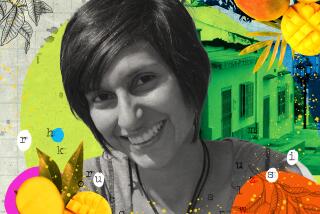In other words -- that’s what she does
New York — New York
Sure, translating “Don Quixote” was a daunting task. But Edith Grossman claims it wasn’t the language that was the problem; it was the four centuries of historical baggage that came with Miguel de Cervantes’ classic picaresque novel.
“The perils and pitfalls involved in translating the book are in the 400 years of scholarship that exists,” Grossman says. “It was somewhat overwhelming to take this book on and confront the person a friend once called ‘Professor Horrendo,’ the person who is waiting to find the mistake, the place you slipped up.”
Grossman needn’t have worried. Her fluid work with “Don Quixote” has earned unanimous praise, and the book is already in its third printing -- an astonishing feat for a 930-page novel written in the early 17th century.
Coupled with Grossman’s graceful and poetic translation of Gabriel Garcia Marquez’s autobiographical “Living to Tell the Tale,” the Upper West Side resident has now established herself as one of the finest and most high-profile translators in publishing.
All well and good. But as Grossman might see it, that’s damning her with faint praise. “Translation is very solitary work,” she says, “and there is a great reluctance in the U.S. to publish translations. Very occasionally, in the case of the ‘Quixote,’ or when Seamus Heaney translated ‘Beowulf,’ a translation makes a huge impact. But most of the time we don’t. I struggle to get my name on the cover.”
Grossman, who has also translated Garcia Marquez’s “Love in the Time of Cholera” as well as the work of Mario Vargas Llosa, Alvaro Mutis and other Spanish-language writers, is a Philadelphian who earned a doctorate in Latin American literature from New York University.
When Garcia Marquez’s previous translator, Gregory Rabassa, was unavailable to do “Cholera” in the 1980s, Grossman was working as a college teacher and translating poetry and short stories for a literary magazine. She beat out several peers and was chosen to translate the work, establishing her reputation.
“A lot of translation has to do with how much English you know,” she says. “When I started on ‘Cholera,’ it seemed to me that the echo behind Garcia Marquez’s writing, and the echo behind almost everyone who writes in Spanish, is Cervantes. But in English there isn’t a model in prose that operates in the way Cervantes does in Spanish. So I decided to use a kind of a 19th century voice by way of William Faulkner.
“I didn’t use any contractions in the narration, and I used Latinate words, polysyllabic words, instead of Germanic monosyllables. Any time I could, I chose a longer word rather than a shorter word, as if Hemingway had never lived.”
Grossman believes that translation is 30% “grunt work” and 70% artistic. There’s a long, involved process of drafts, revisions and editing, which means that an average 300-page book can go through 10 revisions and take four months of seven-day weeks to finish (“Quixote” took two years, but Grossman translated another book in between).
But the really exciting and most creative part is what Grossman describes as “trying to get into the mind of the author through the text. You hear the level of language, of diction, the humor, emotive content. And then you find the voice in English that matches it.”
A small example: A person who gives instruction can be called a teacher, a guru, an instructor, a maestro. “They all mean the same thing,” Grossman says, “but which one do you choose to translate a word? You have to figure out what the author really meant.”
Sometimes this means referring to the six Spanish-language dictionaries she has in her apartment. Sometimes conferring with Latino friends, U.N. translators, native speakers familiar with regional speech or the author.
Grossman doesn’t consult with an author during the translation process, but if there are still problems at the end, she’ll ask the writer “what was meant. I never ask for a translation; I ask what the word means.”
And although she has a personal relationship with her authors -- she will, for example, have coffee with Garcia Marquez if he’s in town -- not all of them are interested in seeing the translation before it goes into print.
But Spanish author Julian Rios, who is fluent in English, always vets his work, and because “he is a very complex writer,” Grossman says, “I’m glad he wants to see the manuscript before I submit it to the publisher.”
When Grossman was starting out in the 1970s, she and other translators were making what could be called slave wages: $45 for a 1,000-word story, 50 cents a line for poetry (that’s a whopping $7 for an entire sonnet).
But fees have slowly gone up, she says, and Grossman is not only able to make a living solely as a translator now, but her status is such that she also earns royalties.
*
For the love of it
Still, translating is more about love than money. Grossman was initially attracted to the field because it allowed her to work at home (she was a heavy smoker at the time and couldn’t work in libraries) and also because “it was a way of satisfying my desire to write. I had written intermittently, and translating is a way to get past the blank page.”
But the opportunities aren’t plentiful. “Who knows which is the egg or the chicken?” Grossman says. “Do Americans read fewer translations because the publishers publish fewer, or the publisher puts out fewer translations because the public reads fewer?”
Whatever the case, demand is limited. “Phillip Roth once said there are only 4,000 readers in the U.S., and once you’ve sold a book to each one of them, you’re done, that’s the end of it. He was exaggerating, but basically that’s the situation.... and translated literature doesn’t do better than English-language literature.”
But there’s a missionary aspect to what she does that surpasses sales figures.
“The more attention that’s paid to translating, the better it is for all translators,” she says. “There is so much literature in the world, so much we deprive ourselves of. Translation is so important to our experience of the world.”
*
(BEGIN TEXT OF INFOBOX)
The man of La Mancha: ‘hidalgo’ or ‘gentleman’?
An excerpt from Chapter 1 of “Don Quixote” as translated by John Rutherford for a 2001 Penguin Books edition:
“In a village in La Mancha, the name of which I cannot quite recall, there lived not long ago one of those country gentlemen or hidalgos who keep a lance in a rack, an ancient leather shield, a scrawny hack and a greyhound for coursing. A midday stew with rather more shin of beef than leg of lamb, the leftover for supper most nights, lardy eggs on Saturdays, lentil broth on Fridays and an occasional pigeon as a Sunday treat ate up most of his income. The rest went on a cape of black broadcloth with breeches of velvet and slippers to match for holy days, and on weekdays he walked proudly in the finest homespun. He maintained a housekeeper the wrong side of forty, a niece the right side of twenty and a jack of all trades who was as good at saddling the nag as at plying the shears. Our hidalgo himself was nearly fifty; he had a robust constitution, dried-up flesh and a withered face, and he was an early riser and a keen huntsman.”
*
The same passage from the new translation by Edith Grossman for
Ecco:
“Somewhere in La Mancha, in a place whose name I do not care to remember, a gentleman lived not long ago, one of those who has a lance and ancient shield on a shelf and keeps a skinny nag and a greyhound for racing. An occasional stew, beef more often than lamb, hash most nights, eggs and abstinence on Saturdays, lentils on Fridays, sometimes squab as a treat on Sundays -- these consumed three-fourths of his income. The rest went for a light woolen tunic and velvet breeches and hose of the same material for feast days, while weekdays were honored with dun-colored coarse cloth. He had a housekeeper past forty, a niece not yet twenty, and a man-of-all-work who did everything from saddling the horse to pruning the trees. Our gentleman was approximately fifty years old; his complexion was weathered, his flesh scrawny, his face gaunt, and he was a very early riser and a great lover of the hunt.”
More to Read
Sign up for our Book Club newsletter
Get the latest news, events and more from the Los Angeles Times Book Club, and help us get L.A. reading and talking.
You may occasionally receive promotional content from the Los Angeles Times.








